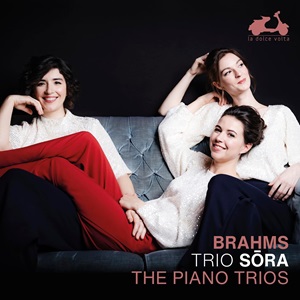
Johannes Brahms (1833-1897)
Trio for piano, violin and cello No 1 in B minor, Op 8 (1853)
Trio for piano, violin and cello No 2 in C major, Op 87 (1880-1882)
Trio for piano, violin and cello No 3 in C minor, Op 101 (1886)
Trio for horn, violin and piano in E-flat major, Op 40 (arr. for cello by Brahms) (1865)
Lullaby Op 49 No 4 (arr. for piano trio by Mathieu Herzog)
Trio Sōra
rec. 2023, MC3 Auditorium, Grenoble, France
La Dolce Volta LDV 132.3 [2 CDs: 114]
Pianist Pauline Chesnais and cellist Angèle Legasa established Trio Sōra in 2015. There have been several violinists since then; presently it is Fanny Fhederoff. “Sōra” derives from the Latin word for “sister”. This is an apt title for three musicians who not only form a cohesive musical entity, but – as the copious notes accompanying these discs show – take a great deal of time to conceptualize their performances before committing them to disc.
Their first recording was a set of Beethoven’s complete piano trios (review). This release is almost equally ambitious: Brahms’s three piano trios and his arrangement of Horn Trio, Op 40. These four, and the 1891 Clarinet Trio, are evidence that the trio format occupied Brahms throughout his career. He wrote Piano Trio No 1 when he was twenty and stayed with Robert and Clara Schumann. It was an emotionally turbulent time for him, and the emotions are manifested in the trio. At the same time, his solid musical identity was already well established, and Trio Sōra convey this duality most convincingly. Their playing is very precise, especially in the Scherzo movement. Although the slow movement drags a little, their playing in the final movement more than compensates for that.
Strong emotions of a different type pervade the Horn Trio. Little of the intensity is lost when the cello replaces the horn. The work was an elegy for the composer’s mother, who had recently died. The opening Allegro is like a solemn lullaby. Trio Sōra do wonders with its many legato passages, especially on the cello. I found the playing in the Scherzo a little disjointed, but again the players more than make up for it by their rendition of the slow movement and final Allegro.
About fifteen years after writing the Horn Trio, Brahms started on not one but two piano trios. He had by then already written his first two symphonies, among other now famous works. He eventually abandoned one trio and concentrated on the other, which became Op 87. It is a work of the composer’s full maturity. The opening Allegro movement is lighter in texture and mood than those in its predecessors, and the musicians bring it out well. Their best playing is reserved for the Andante, a set of variations almost unequalled in Brahms’s output of works in this form. Their presentation of the individual variations is exemplary. They also do well with the enigmatic Scherzo and the complex final movement.
A few years later, Brahms wrote his third and last piano trio. A work of far greater compression than the earlier trios, it lacks nothing in feeling and intensity. In the opening movement, Trio Sōra outdo themselves with the contrast between the vehemence of the first theme and the gentleness of the second. Special notice goes to the slow movement, which features wonderful solo piano and solo violin playing. They also do well with the contrast between the wistful Intermezzo third movement and the hard-driving Finale.
This is an excellently conceived and performed set. The musicians are surely contemplating their next recordings: perhaps Dvořák’s trios? I would put in a request for Tchaikovsky’s Op 50.
William Kreindler
Buying this recording via a link below generates revenue for MWI and helps us keep free access to the site




















